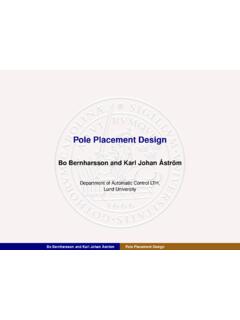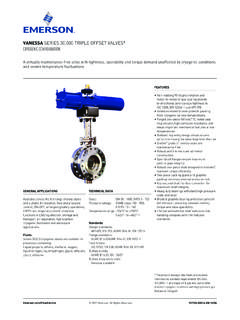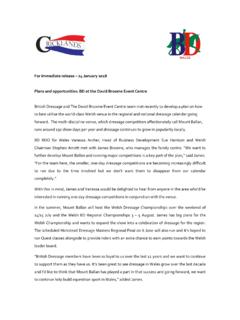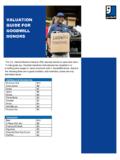Transcription of HistoryofControl HistoryofPLCandDCS - Automatic …
1 History of ControlHistory of PLC and DCSV anessa Romero Segovia and Alfred Theorin2012-06-15 (minor revision 2013-07-26)1 IntroductionThe way many industrial processes look today, is the result of manyyears ofresearch and hard work of people commited to improve their functionality, man-agement, and organization. One could recall the phrase necessity is the motherof invention , and certainly this would fit the everyday work of control engineersand technicians working in industrial processes during the 50 s and 60 s. Thisnecessity was the origin of devices such as the Programmable Logic Controller(PLC) and the Distributed Control System (DCS).2 Programmable Logic Controller (PLC)A programmable logic controller (PLC) is an industrially hardened computer-based unit that performs discrete or continuous control functions in a variety ofprocessing plant and factory environments.
2 It was originally intended as a relayreplacement equipment for the automotive industry. Nowadays the PLC is usedin virtually every industry imaginable. Though they were commonly referred toas PCs before 1980, PLC became the accepted abbreviation for programmablelogic controllers, as the term PC became synonymous with personal computersin recent sheer number of PLC applications is enormous. According to a recentControl Engineering magazine poll, The major applications for PLCsincludemachine control (87%), process control (58%), motion control(40%), batchcontrol (26%), diagnostic (18%), and other (3%). The results dont add up to100% because a single control system generally has multiple are produced and sold worldwide as stand-alone equipment by severalmajor control equipment manufacturers.
3 In addition, a variety of more spe-cialized companies produce PLCs for original equipment manufacturer (OEM) The Birth of the PLCThe early history of the PLC goes back to the 1960 s when control systems werestill handled using relay control. During this time the control rooms consistedof several walls containing many relays, terminal blocks and mass problems related to such kind of systems were many, among those one couldmention: The lack of flexibility to expand the process, as well as the inordinateamount of time needed to adjust the process when changes were needed. Troubleshooting which covered from dirty contacts, loose wires, outdatedprints on the terminal blocks with informal nomenclature, to cryptic con-nection problems were faced continuously by technician and controlengineers.
4 Atthis time the adage Five hours to find it and five minutes to fix it was 1: Manual relay panels from the early 1968 Bill Stone, who was part of a group of engineers at the HydramaticDivision of General Motors Corporation, presented a paper at theWestinghouseConference outlining their problems with reliability and documentationfor themachines at this plant. He also presented a design criteria developedby theGM engineers for a standard machine controller .According to the criteria developed, the early model of this machinenot only hadto eliminate costly scrapping of assembly-line relays during model changeoversand replace unreliable electromechanical relays, but also: Extend the advantages of static circuits to 90% of the machines in theplant.
5 Reduce machine downtime related to controls problems, easily maintainedand programmed in line with already accepted relay ladder logic. Provide for future expansion, it had to be modular to allow for easy ex-change of components and expandability. It had to work in an industrial environment with all it s dirt, moisture,electromagnetism and vibration. Include full logic capabilities, except for data reduction specifications along with a proposal request to build a prototype, weregiven to four control builders: Allen-Bradley, by way of Michigan-based Information Instruments, Inc. Digital Equipment Corporation (DEC). Century Detroit. Bedford The Race is OnConsidering the proposal request, the team of Digital Equipment brought a mini-computer into GM, which finally was rejected for many reasons, fromwhich static memory was one of its serious , already well known for it s rheostats, relays and motor controls,responded at the risk of competing with one of its most successfulcore businesswhich was the electromechanical relays.
6 Expecting to fulfill the requirements ofthe proposal, Allen-Bradley went from prototype to actual production in fivemonths. The first attempt, the PDQ-II or program data quantizier, was deemedtoo large, too complex and too hard to program. The second attempt, the PMCor programmable matrix controller, was smaller and easier to program, but stillit was not able to fully serve customer needs for machine the time of the proposal, people at Bedford Associates, which includedRichard Morley, Mike Greenberg, Jonas Landau, George Schwenk and TomBoissevain, were already working on the design of a unit, which characteristicsincluded a modular and rugged design, the use of no interrupts for processing, aswell as direct mapping into memory.
7 The Bedford team named this unitas the084, since it was the 84th project for the company. After finding some financialsupport, the team decided to form a new company called Modicon (MOdularDIgital CONtroller) which worked closely with Bedford to create team at Modicon was finishing the design and build of the 084, thatnowthey were calling the programmable controller (PC).Finally in 1969, the winning proposal came from Bedford Associates and Modi-con, when they demonstrated at GM the Modicon 084 solid-state sequential logicsolver. The Modicon 084 consisted of three distinct components that includedthe processor board, the memory, and the logic solver board, which solved thedominant algorithms associated with ladder the Modicon 084 was designed, it was built rugged with no ON/OFFswitch, totally enclosed with conductive cooling, it was designed to fans were used, and outside air.
8 As Richard Morley explains, No fanswere used, and outside air was not allowed to enter the system for fear ofcontamination and corrosion. Mentally, we had imagined the programmablecontroller being underneath a truck, in the open, and being driven around inTexas, in Alaska. Under those circumstances, we wanted it to survive. The otherrequirement was that it stood on a pole, helping run a utility or a microwavestation which was not climate controlled, and not serviced at all . The History goes OnBy 1971, Odo Struger and Ernst Dummermuth engineers of Allen-Bradley, hadbegun to develop a new concept that included improvements based on the cus-tomer needs that could not be fulfilled by its second attempt, the PMC.
9 Thisnew concept was known as the Bulletin 1774 PLC. Allen-Bradley namedthisnew device as the Programmable Logic Controller (PLC) over the then ac-cepted term Programmable Controller . The PLC terminology became the4 Figure 2: Historical photo showing from left to right: Dick Morley, Tom Bois-sevain, Modicon 084, George Schwenk, and Jonas standard especially when PC became associated with personal com-puters. In 1985 Rockwell Automation acquired Allen-Bradley. The name of thenew produced products are still associated to this time Modicon was already gaining experiences through theModicon084. Based on this experience, the design cycle by Michael Greenberg, and themarketing ideas of Lee Rousseau, the Modicon 184 was born in newmodel not only met the needs of the marketplace and the costumers, but alsoproduced the take off of the Modicon company, setting it as the early leaderin the market.
10 Eventually the success of Modicon caused the dissolution ofBedford Associates, to avoid tax issues. In 1977 Modicon was sold to GouldElectronics, and later in 1997 to Schneider Electric, which still owns the brandtoday, and uses the Modicon the 1970 s, seven companies were in the PLC business, including con-tenders Allen-Bradley, Modicon, General Electric, Square D and Industrial SolidState Controls. And although PLCs were obviously a breakthroughthat wouldrevolutionize automation, they were still comparatively primitive. They werelargely developed and used for specific applications, most often in the automo-tive early days of the PLCs however, were not as straightforwardnor as were many things that made the acceptance of the PLCs very Morley explains, We had some real problems in the early days of convincingpeople that a box of software, albeit cased in cast iron, could do thesame thingas 50 feet of cabinets, associated relays, and wiring.










